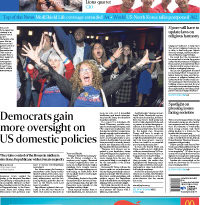ECONOMY | HÀ NỘI- Capital City commits to bold 2024 agenda prioritising economic revival, infrastructure advancement
 |
The second phase of Vĩnh Tuy Bridge, or Vĩnh Tuy Bridge 2, which spans the Red River and connects Hà Nội’s Hai Bà Trưng and Long Biên districts, officially opened to traffic on August 30. VNA/VNS Photo
Hà Nội is poised to overcome difficulties, implementing the Action Programme and the Politburo’s Resolution to develop the Capital until 2030, with a vision to 2045, ensuring its readiness for a productive 2024.
.
.
HÀ NỘI — Hà Nội sets forth an ambitious agenda centred on economic revival, infrastructure advancement, and pioneering growth for the year 2024. Despite confronting challenges, the Capital city’s administration reveals a sweeping plan designed to establish Hà Nội as a modernised industrial hub.
In 2023, Hà Nội faced formidable challenges, with 4 out of 23 targets predicted to miss the mark: Gross Regional Domestic Product (GRDP) expected to grow by 6.11 per cent (against a 7.0 per cent plan); Realised investment capital’s estimated increase at 9.0 per cent (below the 10.5 per cent target); Export turnover growth rate forecast at 1.0 per cent (compared to the 6.0 per cent plan); and industrial clusters’ wastewater treatment meeting standards at 95 per cent (falling short of the 100 per cent goal).
 Memento Maxima Digital Marketin
Memento Maxima Digital Marketin
@[email protected]
SPACE RESERVE FOR ADVERTISEMENT
.
The City People’s Committee acknowledges sustained economic growth amid adversity but at a lower level than the previous period, attributed to the enduring impact of the COVID-19 pandemic. Factors include a decline in domestic and foreign consumer demand, reduced export-import turnover, enterprises grappling with difficulties, and the industrial, construction, and service sectors failing to meet their targets.
While social investment capital increased by 9.0 per cent, it fell short of the 10.5 per cent target, primarily due to the domestic and world economic decline. Subjectively, challenges stem from a stagnant investment and business environment, evident in downgraded PCI and PAPI (Provincial Competitiveness Index and Public Administration Performance Index) scores, and asynchronous infrastructure development, especially incomplete industrial zones hindering investment attraction.
Credit institutions’ loan balance rose slightly but did not meet the set target, coupled with unexpected shortfalls in the 2 per cent interest rate support policy from the state budget. Subjective issues on the business side include complexities for multi-industry businesses, difficulties in separating supported costs, limited financial capacity for small and micro-scale enterprises, absence of viable business plans, lack of financial transparency, insufficient collateral, and post-COVID business challenges.
 Memento Maxima Digital Marketin
Memento Maxima Digital Marketin
@[email protected]
SPACE RESERVE FOR ADVERTISEMENT
.
Complications persist in mechanisms, policies and administration at all government levels, affecting production and business support. The survey reveals challenges for small and medium-sized enterprises in accessing the State’s loan support package, with 79.44 per cent citing the inability to borrow capital without collateral, 58.72 per cent facing unfavourable credit conditions, and 58.63 per cent finding loan procedures overly complicated.
Public investment capital disbursement reached 60.8 per cent, exceeding the same period in 2022 but falling short of the target due to prolonged difficulties, including issues in site clearance, determination of land origin and valuation, and inadequate investment preparation, causing adjustments to projects.
Specific challenges in 2023 include project-related issues such as raw material price fluctuations, supply chain disruptions, problems in ODA-funded projects, and slow approval of investment and policy adjustments. The slow completion of investment procedures, especially in monument-related projects, affects revenue from land use rights auctions.
Management challenges encompass delays in urban development and environmental protection projects, lagging behind schedules due to simultaneous planning at national, regional and provincial levels. Limited awareness of the importance and requirements of Capital Planning adds to the implementation challenges.
Task implementation lags in projects like online traffic maps, the elevated section of the Nhổn – Hà Nội Railway Station, renovation of old apartment buildings and environmental protection initiatives. Subjective factors include a lack of decisive leadership, limited official capacity, and ineffective inter-departmental coordination.
 Memento Maxima Digital Marketin
Memento Maxima Digital Marketin
@[email protected]
SPACE RESERVE FOR ADVERTISEMENT
.
Solutions for the year to come
Hà Minh Hải, Vice Chairman of Hà Nội People’s Committee, emphasised that Hà Nội continued to be a focal point for attention from the Politburo, the National Assembly, the Government, and central ministries, departments and branches. Long-term development documents for the Capital would be issued to guide resource exploitation and implementation.
Several projects from the Medium-term Public Investment Plan (2021-2025) had been expedited, addressing long-standing bottlenecks, particularly off-budget capital projects using land. An improved investment and business environment would serve as a catalyst for recovery and socio-economic development.
In 2024, Hà Nội aims to sustain growth while controlling inflation, ensuring economic balance, according to the official. The city will foster positive changes by implementing breakthroughs, restructuring the economy, fostering innovation, and enhancing productivity, quality, efficiency, competitiveness and intrinsic capacity.
 Memento Maxima Digital Marketin
Memento Maxima Digital Marketin
@[email protected]
SPACE RESERVE FOR ADVERTISEMENT
.
Administrative reform, digital transformation, and streamlined organisational structures are pivotal.
Focus areas include enhancing the investment and business environment, removing bottlenecks, promoting production, improving rankings in various indices, and fostering comprehensive development in culture, education and health.
The 2024 Socio-Economic Development Plan targets key indicators such as a 6.5-7.0 per cent increase in GRDP, GRDP per person of about VNĐ160-162 million, realised investment capital growth of 10.5-11.5 per cent, and a 4-5 per cent rise in export turnover. To achieve these goals, the City People’s Committee remains committed to key tasks and solutions, striving for growth, inflation control and overall economic balance.
Additionally, Hà Nội focuses on the effective implementation of central monetary and fiscal policies, deploying policies on interest rates and credit to support businesses and priority areas. The city deployed a credit package of VNĐ120 trillion for various projects and an additional VNĐ900 billion through the Hà Nội Bank for Social Policies Branch to enhance the social security system.
 Memento Maxima Digital Marketin
Memento Maxima Digital Marketin
@[email protected]
SPACE RESERVE FOR ADVERTISEMENT
.
Nguyễn Ánh Dương, director of the Hà Nội Promotion Agency, stressed the importance of trade promotion and market expansion.
The agency is dedicated to fostering trade promotion, expanding export markets, and bolstering the effectiveness of promotional activities, according to Dương. This strategic focus is crucial in creating an environment where businesses can showcase and endorse their products, establishing partnerships for collaboration and export opportunities.
The City People’s Committee is resolutely dedicated to supporting businesses through the provision of market information, facilitating registration processes, ensuring brand protection, and encouraging the adoption of quality management systems adhering to international standards. Additionally, efforts are underway to boost production orders for export, with a targeted increase in export turnover by 4-5 per cent.
The city is also actively addressing challenges and expediting the progress of commercial infrastructure projects within the region. The city invites investments in key projects, including an international agricultural wholesale market in Yên Thượng Commune (Gia Lâm District), a general agricultural wholesale market in Mê Linh District, and an outlet project.
Simultaneously, the city is reinforcing its network of markets, shopping centres, supermarkets and convenience stores. The goal is to develop one or two additional shopping centres, up to ten supermarkets, and over 70 convenience stores by 2024. Plans include the inauguration of 10 markets and the commencement of construction for five new markets.
 Memento Maxima Digital Marketin
Memento Maxima Digital Marketin
@[email protected]
SPACE RESERVE FOR ADVERTISEMENT
.
Moreover, research initiatives are underway to establish shopping areas catering to the affluent both domestically and internationally. This encompasses the development of a chain of convenience stores (with attendants), automatic transaction stores, and a vending machine system.
The city is committed to establishing a comprehensive infrastructure system for tourist destinations. This includes the creation of innovative experiential tourism products linked to heritage sites, monuments, and craft villages. Emphasising waterways, the city plans to implement river tourism that connects attractions along the Red River and Đuống River areas. Additionally, a professional community tourism model will be operationalised.
Furthermore, the city aims to develop 2-3 high-quality agricultural tourism models in Thường Tín, Sơn Tây, Ba Vì, and Sóc Sơn districts. As part of this initiative, the city will introduce one or two additional walking street areas coupled with culinary streets and themed cultural performances. The overarching goal is to attract 4.5 million international tourists by 2024, with approximately 3.2 million opting for extended stays.
 Memento Maxima Digital Marketin
Memento Maxima Digital Marketin
@[email protected]
SPACE RESERVE FOR ADVERTISEMENT
.
Additionally, the city targets welcoming 21 million domestic tourists, fostering a vibrant and thriving tourism sector.
Intensifying efforts in the promotion and attraction of investments, Hà Nội prioritises projects that incorporate cutting-edge technology and adhere to environmentally sustainable practices, particularly focusing on the semiconductor industry.
In the upcoming year, the city is dedicated to drawing the participation of 20-25 businesses, aiming to have around 30-35 products recognised as key industrial products of the city. Additionally, the goal is to establish and expand to up to 15 industrial clusters. Simultaneously, the city will finalise a comprehensive set of evaluation criteria and guidelines for establishing and advancing the Creative Design Centre model. By 2025, the objective is for each district and town to boast at least one Creative Design Centre, dedicated to the introduction, promotion and sale of OCOP products, and craft villages with a strong connection to tourism. VNS










